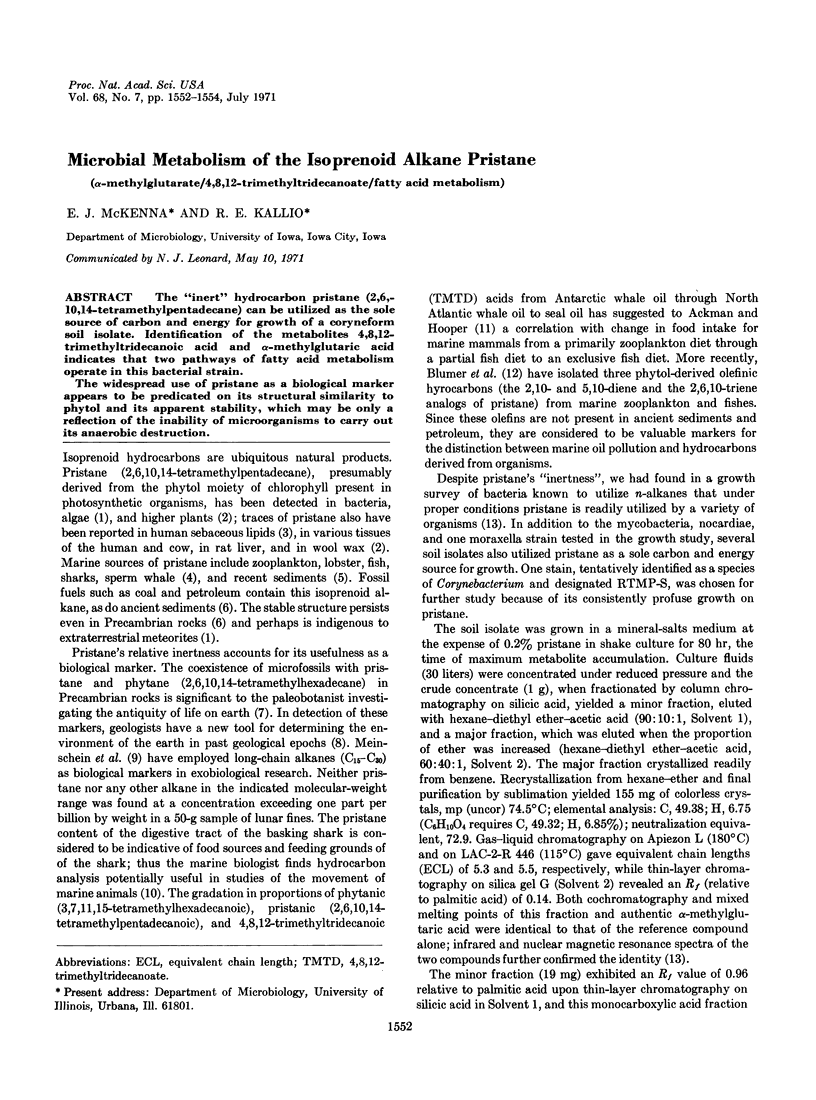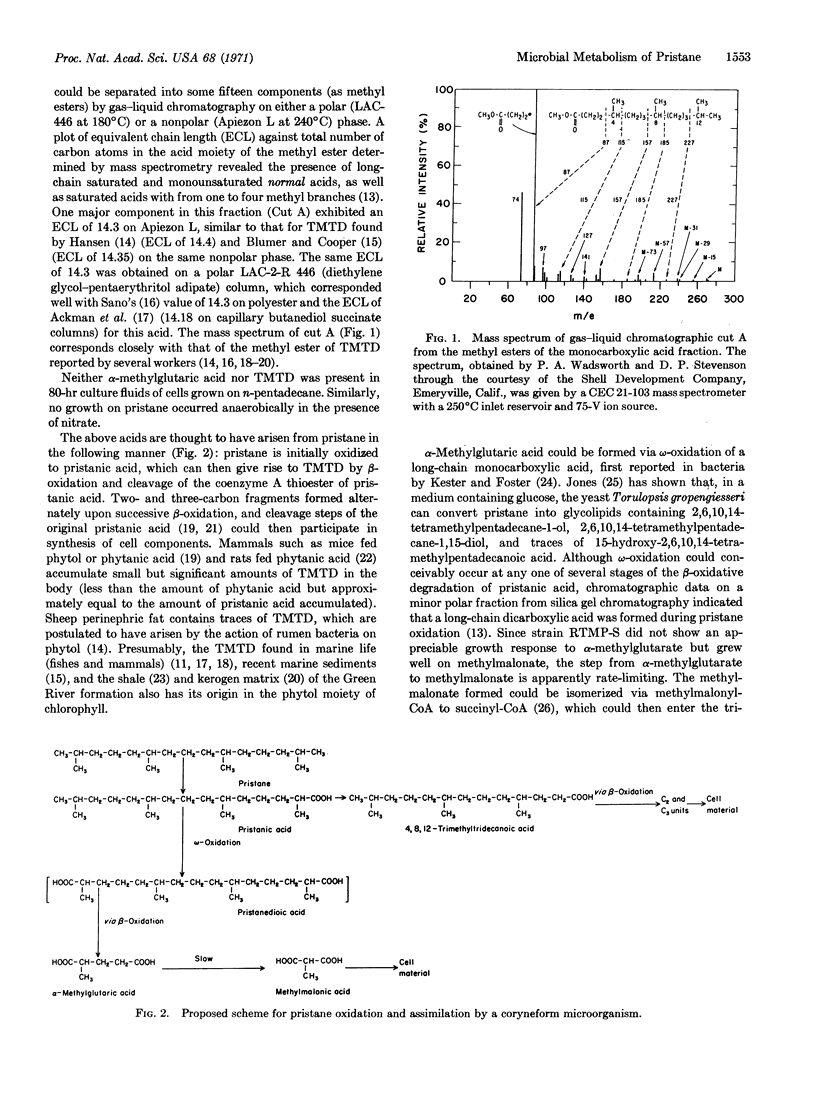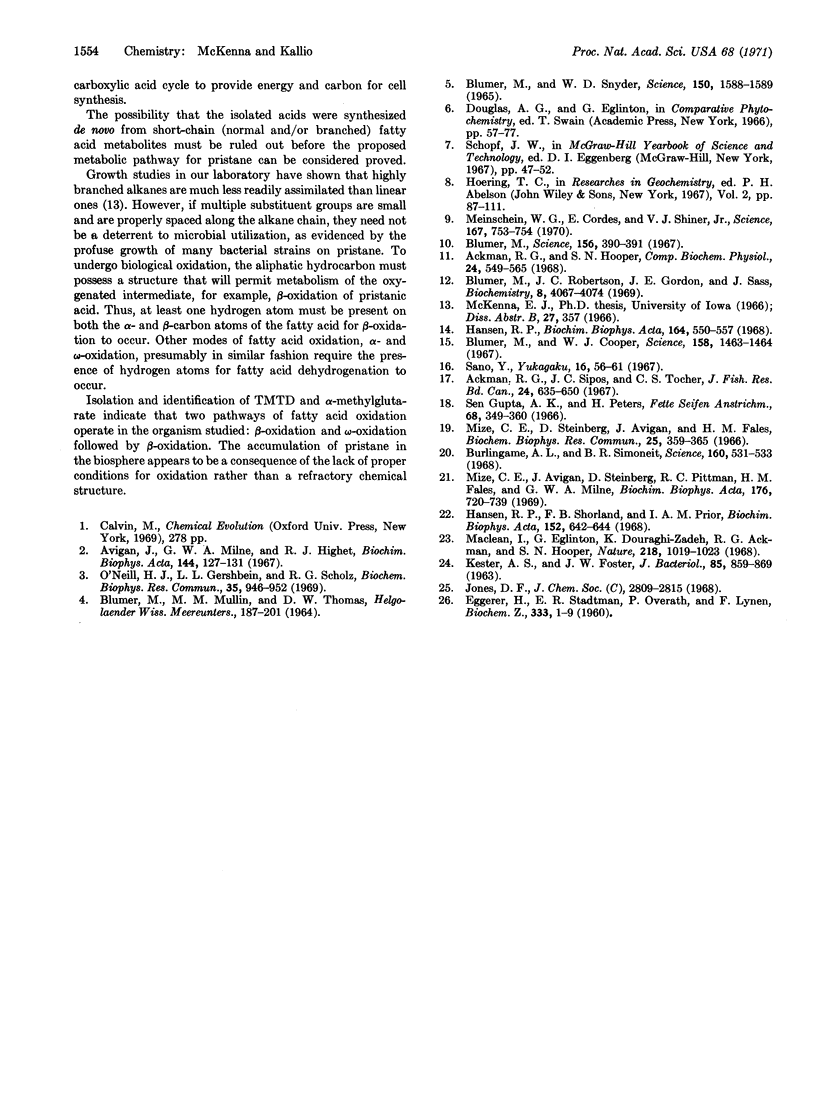Abstract
The “inert” hydrocarbon pristane (2,6,10,14-tetramethylpentadecane) can be utilized as the sole source of carbon and energy for growth of a coryneform soil isolate. Identification of the metabolites 4,8,12-trimethyltridecanoic acid and α-methylglutaric acid indicates that two pathways of fatty acid metabolism operate in this bacterial strain.
The widespread use of pristane as a biological marker appears to be predicated on its structural similarity to phytol and its apparent stability, which may be only a reflection of the inability of microorganisms to carry out its anaerobic destruction.
Keywords: α-methylglutarate; 4,8,12-trimethyltridecanoate; fatty acid metabolism
Full text
PDF


Selected References
These references are in PubMed. This may not be the complete list of references from this article.
- Ackman R. G., Hooper S. N. Examination of isoprenoid fatty acids as distinguishing characteristics of specific marine oils with particular reference to whale oils. Comp Biochem Physiol. 1968 Feb;24(2):549–565. doi: 10.1016/0010-406x(68)91008-6. [DOI] [PubMed] [Google Scholar]
- Avigan J., Milne G. W., Highet R. J. The occurrence of pristane and phytane in man and animals. Biochim Biophys Acta. 1967 Aug 8;144(1):127–131. doi: 10.1016/0005-2760(67)90084-7. [DOI] [PubMed] [Google Scholar]
- Blumer M., Cooper W. J. Isoprenoid acids in recent sediments. Science. 1967 Dec 15;158(3807):1463–1464. doi: 10.1126/science.158.3807.1463. [DOI] [PubMed] [Google Scholar]
- Blumer M. Hydrocarbons in digestive tract and liver of a basking shark. Science. 1967 Apr 21;156(3773):390–391. doi: 10.1126/science.156.3773.390. [DOI] [PubMed] [Google Scholar]
- Blumer M., Robertson J. C., Gordon J. E., Sass J. Phytol-derived C19 di- and triolefinic hydrocarbons in marine zooplankton and fishes. Biochemistry. 1969 Oct;8(10):4067–4074. doi: 10.1021/bi00838a025. [DOI] [PubMed] [Google Scholar]
- Blumer M., Snyder W. D. Isoprenoid Hydrocarbons in Recent Sediments: Presence of Pristane and Probable Absence of Phytane. Science. 1965 Dec 17;150(3703):1588–1589. doi: 10.1126/science.150.3703.1588. [DOI] [PubMed] [Google Scholar]
- Burlingame A. L., Simoneit B. R. Isoprenoid Fatty acids isolated from the kerogen matrix of the green river formation (eocene). Science. 1968 May 3;160(3827):531–533. doi: 10.1126/science.160.3827.531. [DOI] [PubMed] [Google Scholar]
- Hansen R. P. 4,8,12-Trimethyltridecanoic acid: its isolation and identification from sheep perinephric fat. Biochim Biophys Acta. 1968 Dec 18;164(3):550–557. doi: 10.1016/0005-2760(68)90184-7. [DOI] [PubMed] [Google Scholar]
- Hansen R. P., Shorland F. B., Prior I. A. The occurrence of 4,8,12-trimethyltridecanoic acid in the tissues of rats fed high levels of phytanic acid. Biochim Biophys Acta. 1968 May 1;152(3):642–644. doi: 10.1016/0005-2760(68)90108-2. [DOI] [PubMed] [Google Scholar]
- KESTER A. S., FOSTER J. W. DITERMINAL OXIDATION OF LONG-CHAIN ALKANES BY BACTERIA. J Bacteriol. 1963 Apr;85:859–869. doi: 10.1128/jb.85.4.859-869.1963. [DOI] [PMC free article] [PubMed] [Google Scholar]
- Maclean I., Eglinton G., Douraghi-Zadeh K., Ackman R. G., Hooper S. N. Correlation of stereoisomerism in present day and geologically ancient isoprenoid fatty acids. Nature. 1968 Jun 15;218(5146):1019–1024. doi: 10.1038/2181019a0. [DOI] [PubMed] [Google Scholar]
- Meinschein W. G., Cordes E., Shiner V. J., Jr Search for alkanes of 15 to 30 carbon atom length. Science. 1970 Jan 30;167(3918):753–754. doi: 10.1126/science.167.3918.753. [DOI] [PubMed] [Google Scholar]
- Mize C. E., Avigan J., Steinberg D., Pittman R. C., Fales H. M., Milne G. W. A major pathway for the mammalian oxidative degradation of phytanic acid. Biochim Biophys Acta. 1969 Jun 10;176(4):720–739. doi: 10.1016/0005-2760(69)90253-7. [DOI] [PubMed] [Google Scholar]
- Mize C. E., Steinberg D., Avigan J., Fales H. M. A pathway for oxidative degradation of phytanic acid in mammals. Biochem Biophys Res Commun. 1966 Nov 11;25(3):359–365. doi: 10.1016/0006-291x(66)90786-8. [DOI] [PubMed] [Google Scholar]
- O'Neill H. J., Gershbein L. L., Scholz R. G. Identification of pristane in human sebum. Biochem Biophys Res Commun. 1969 Jun 27;35(6):946–952. doi: 10.1016/0006-291x(69)90716-5. [DOI] [PubMed] [Google Scholar]


